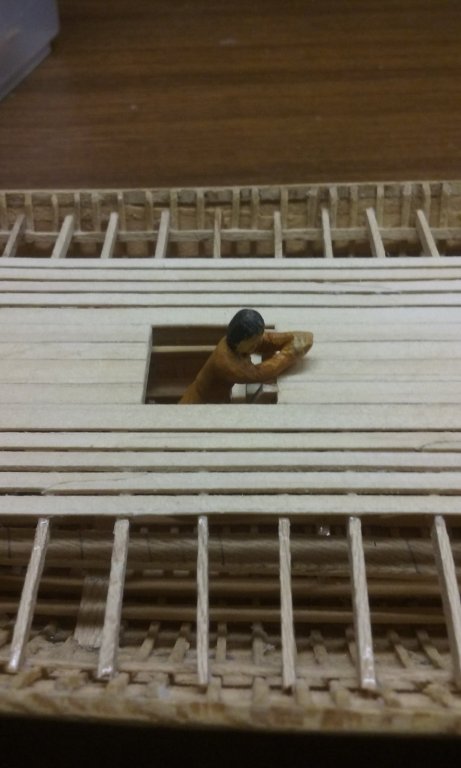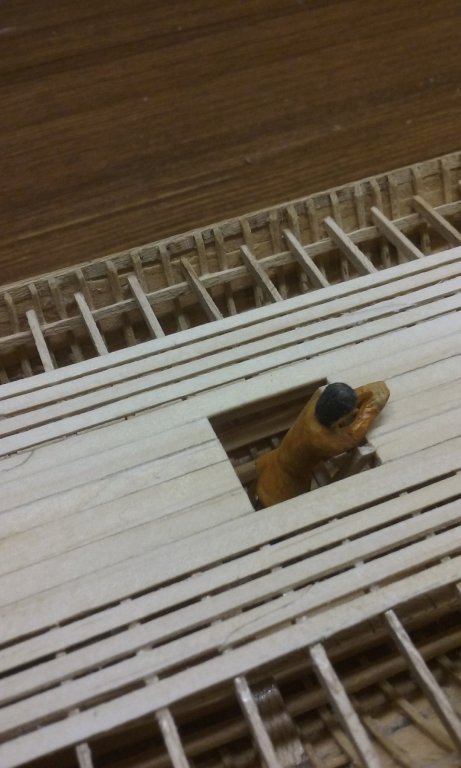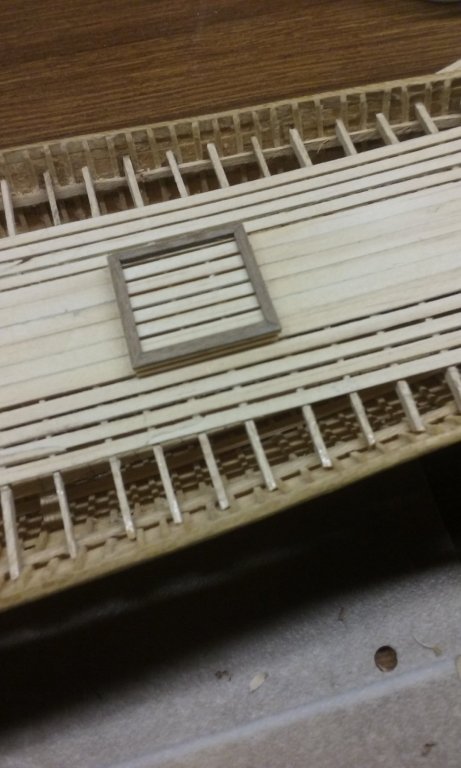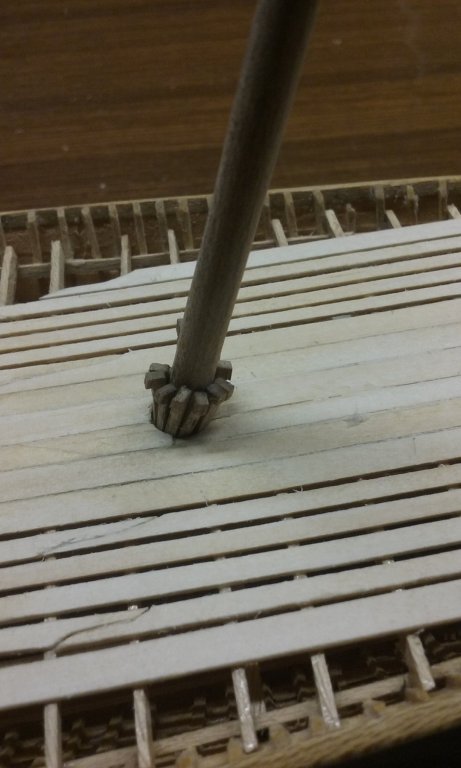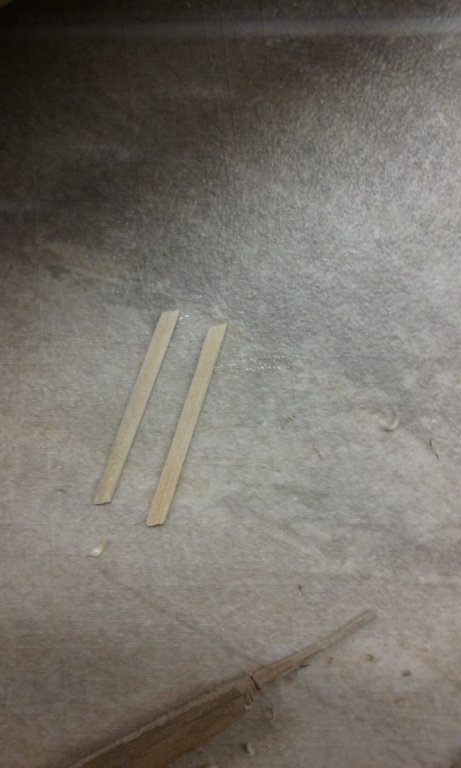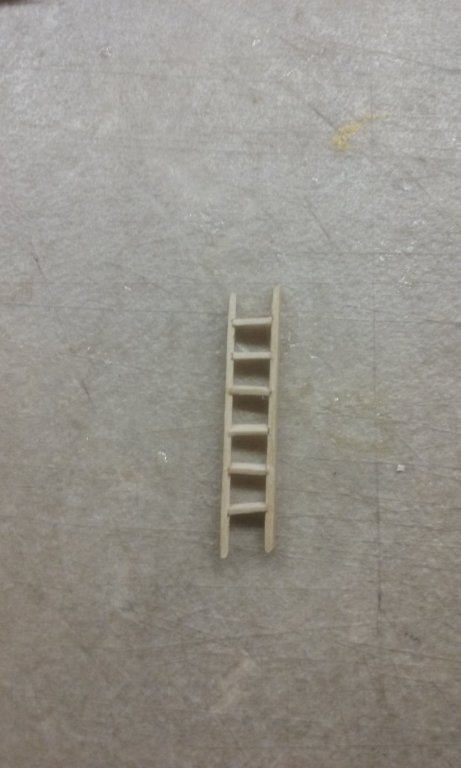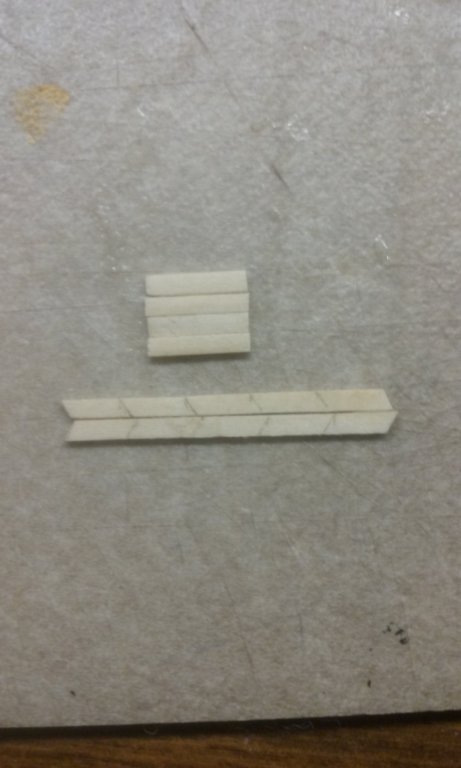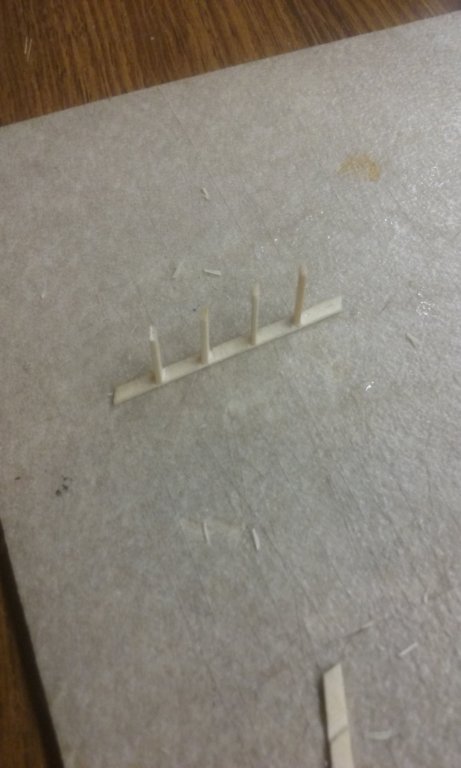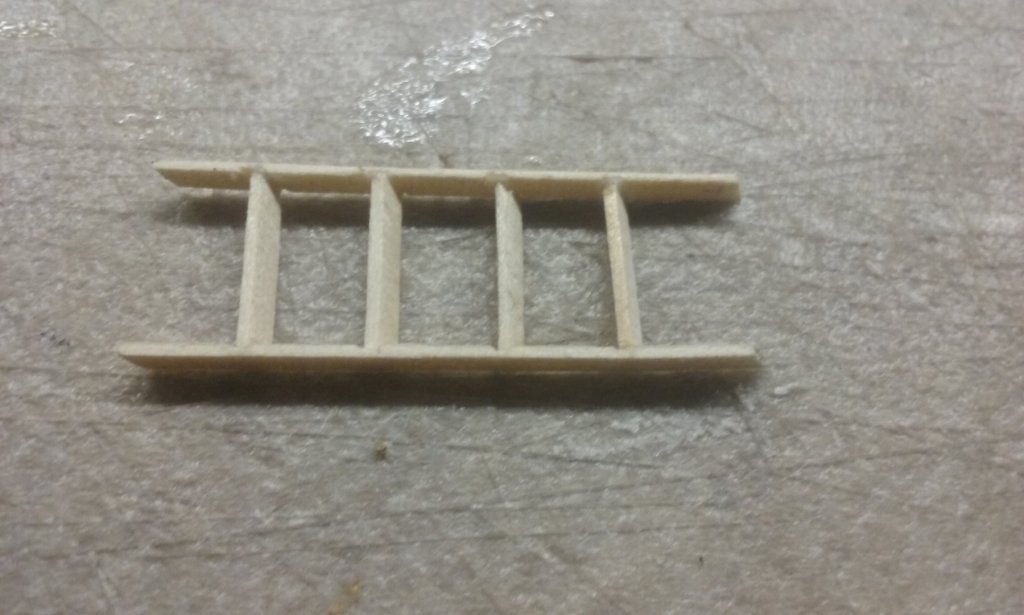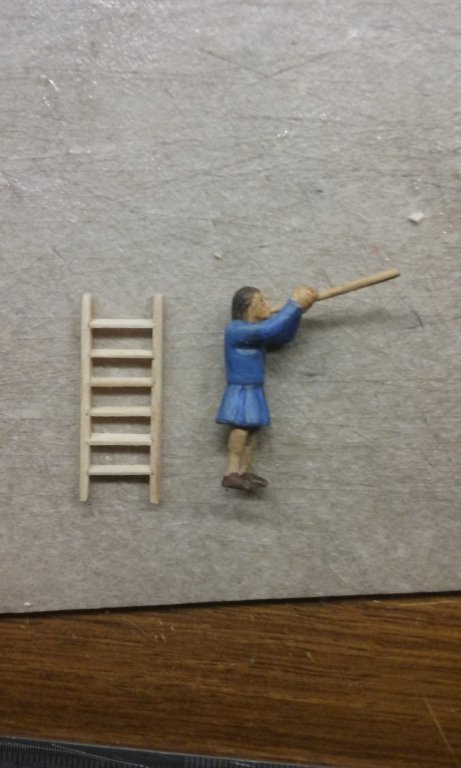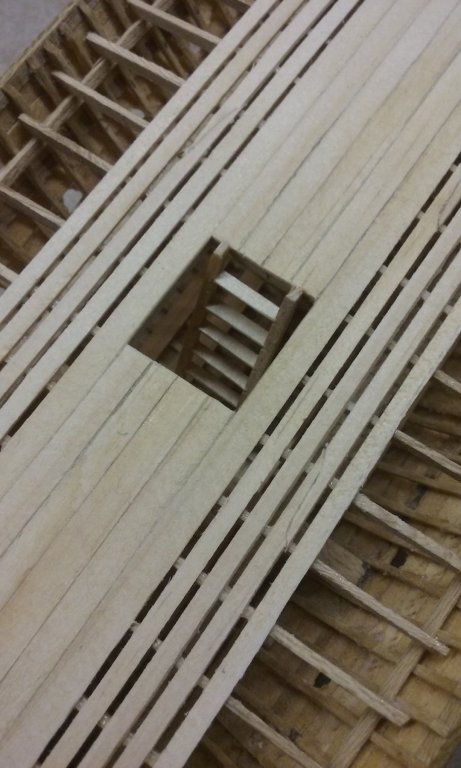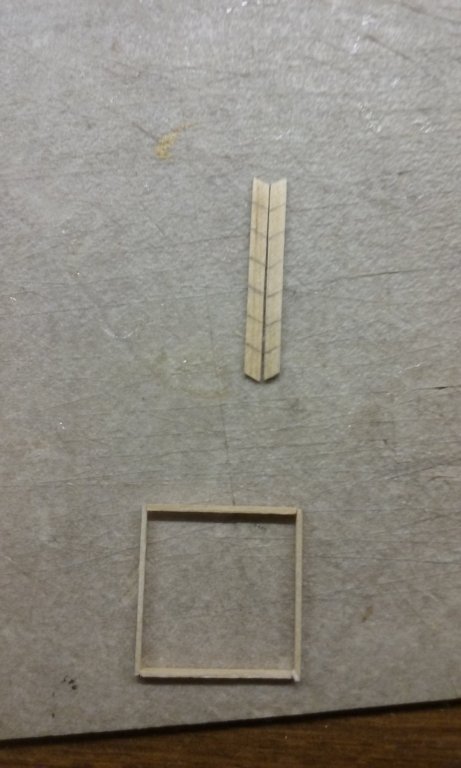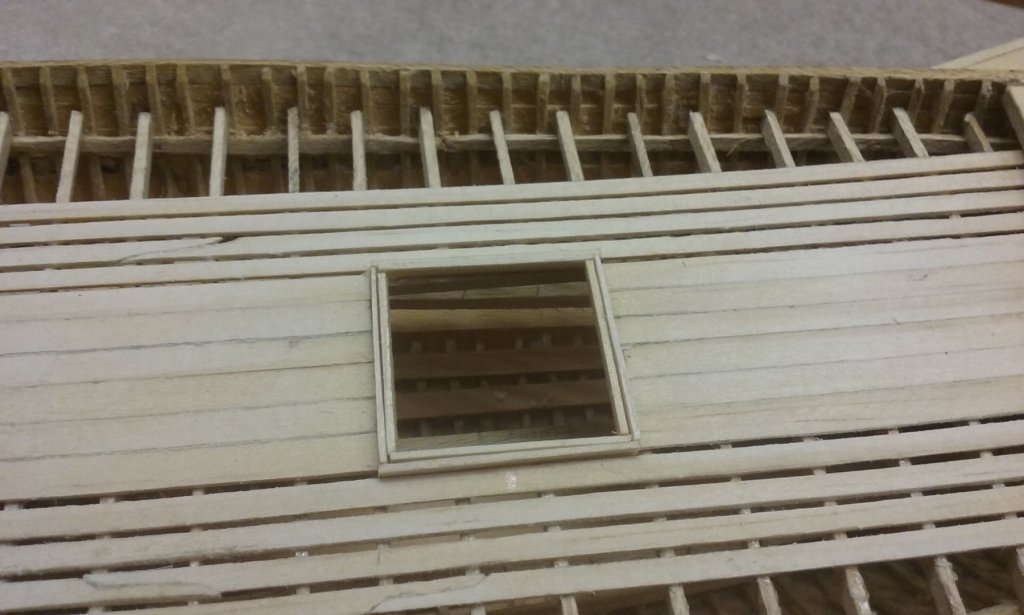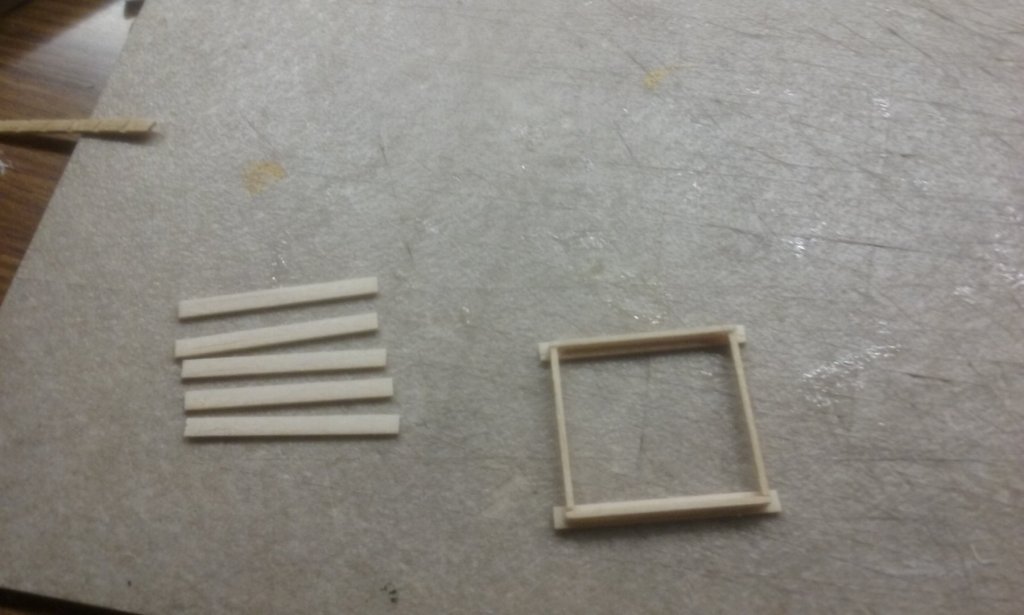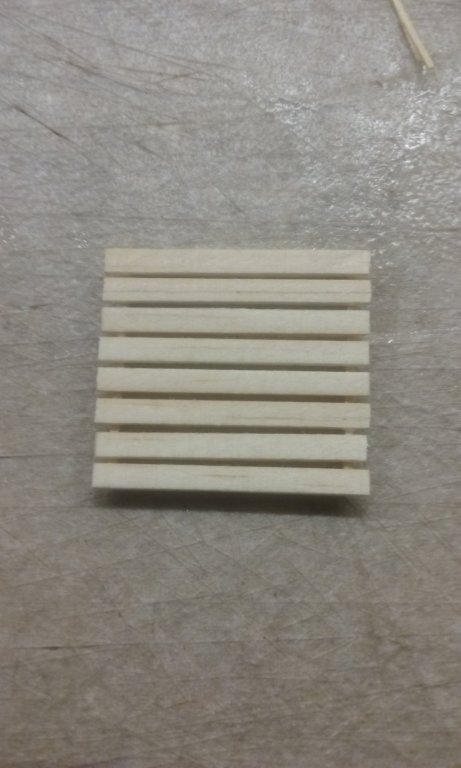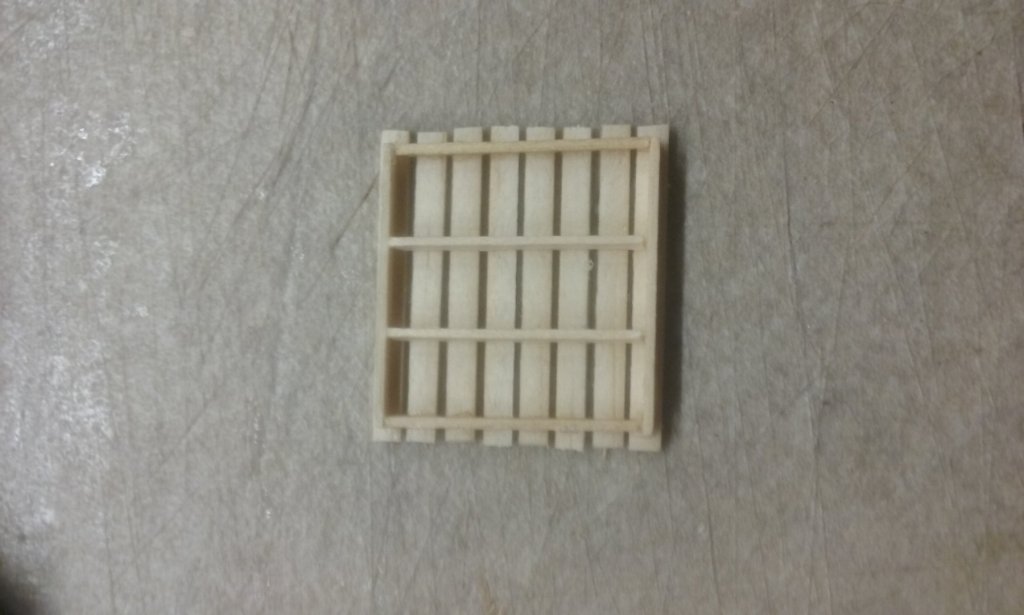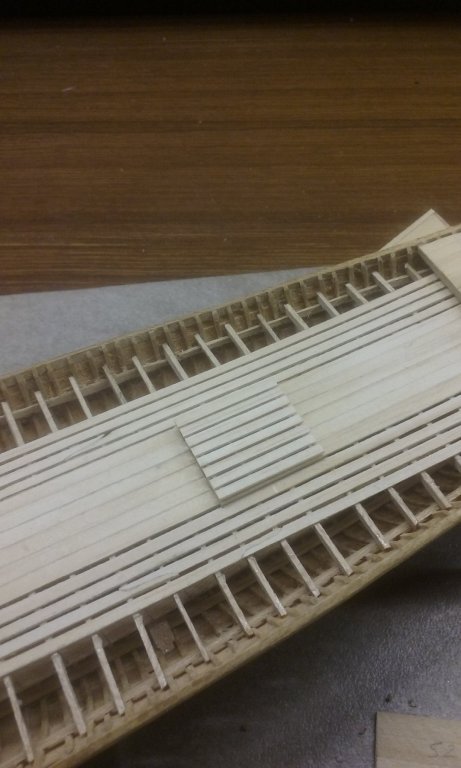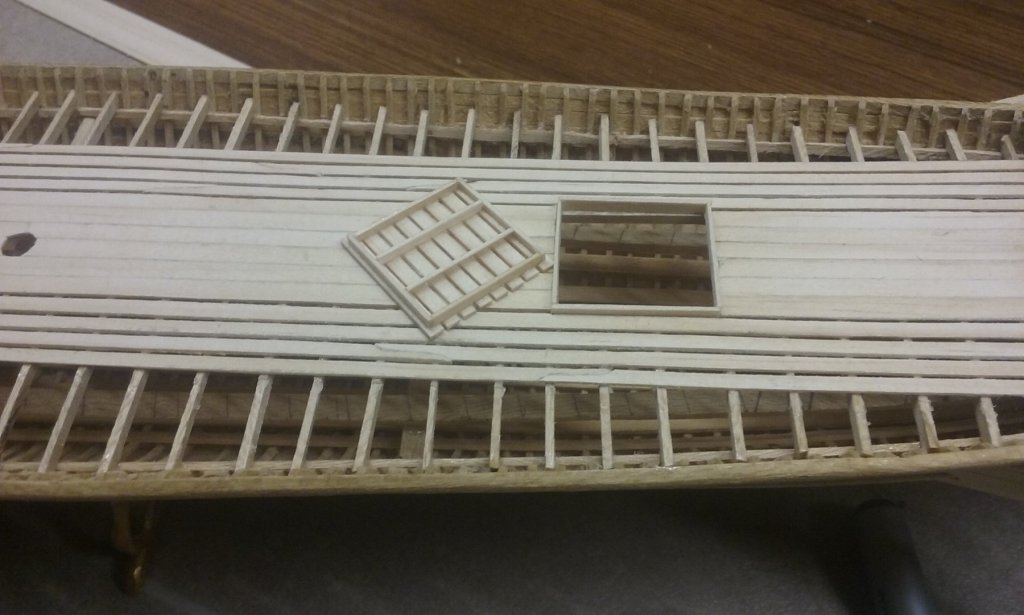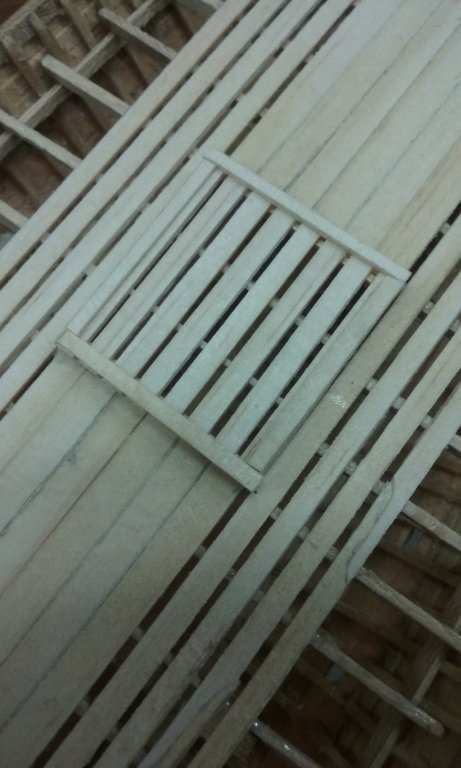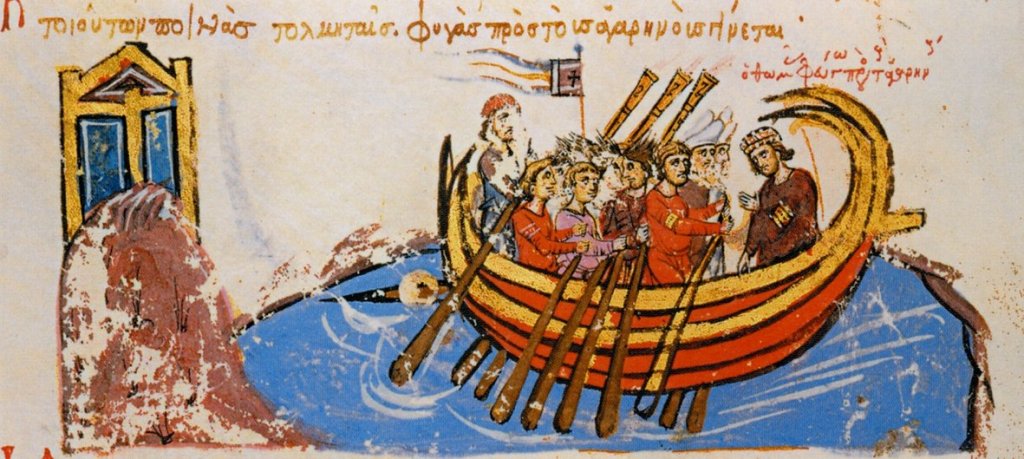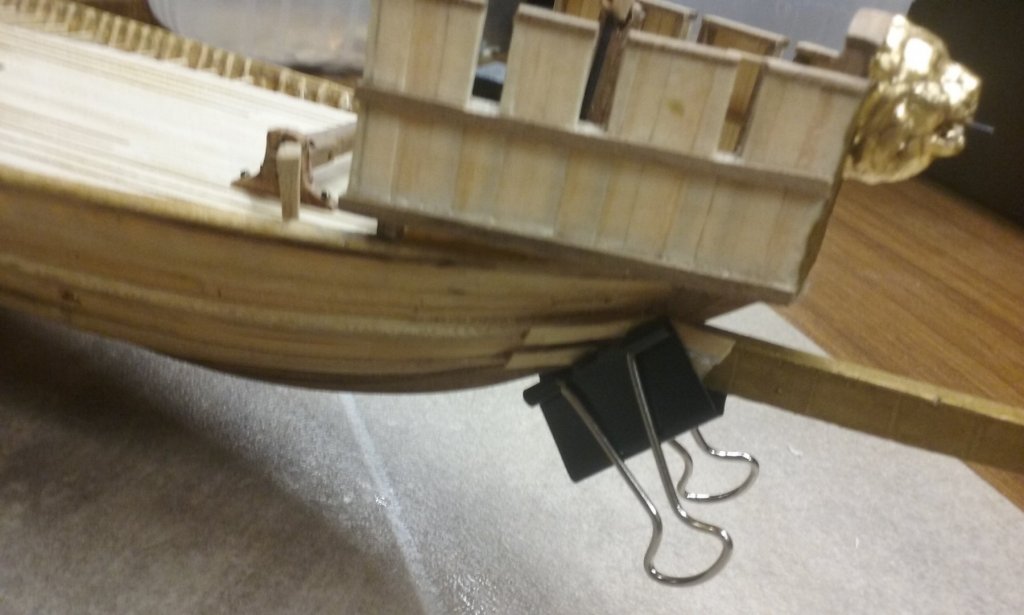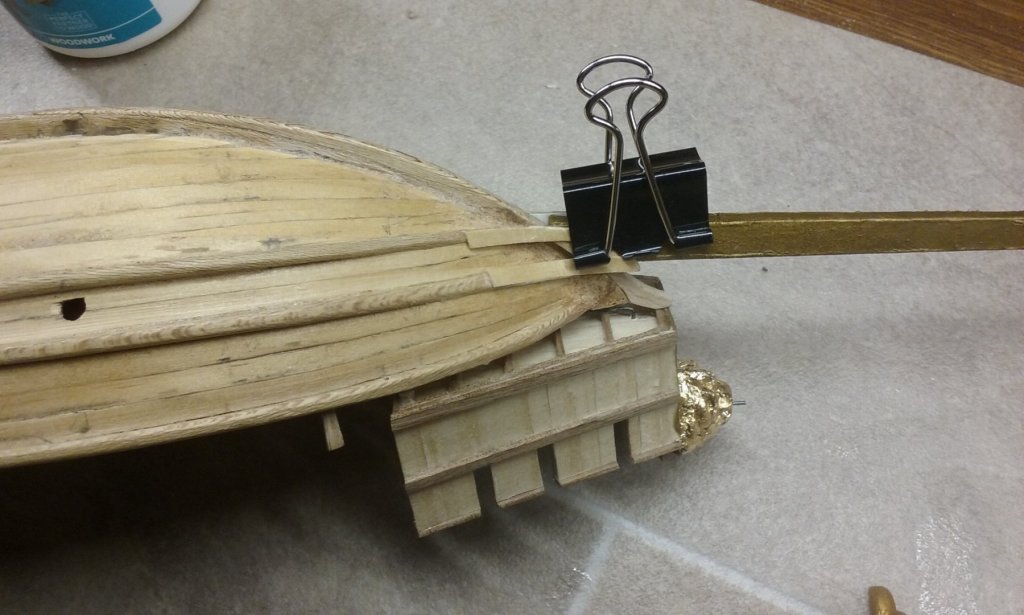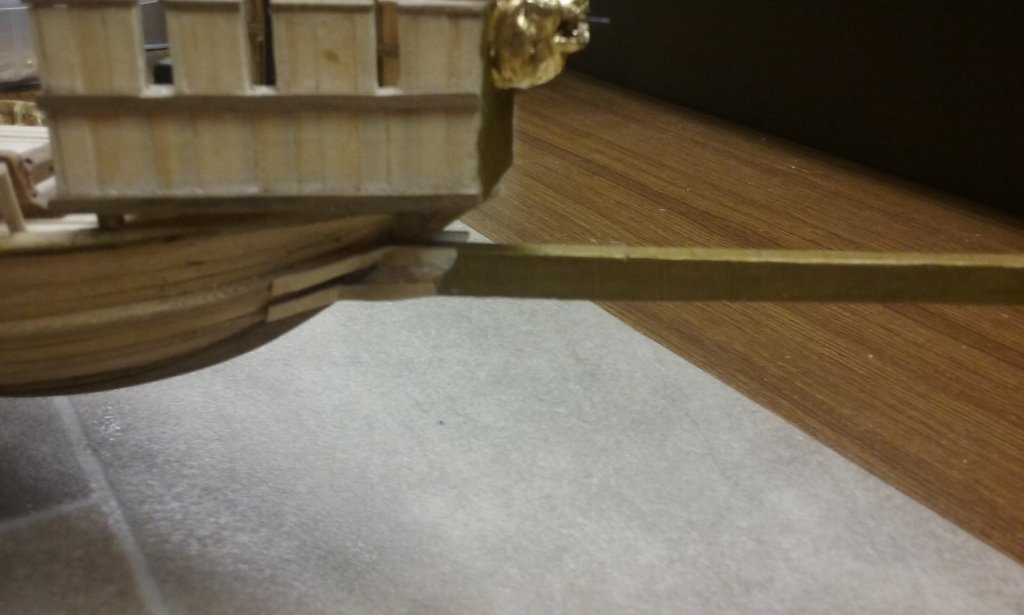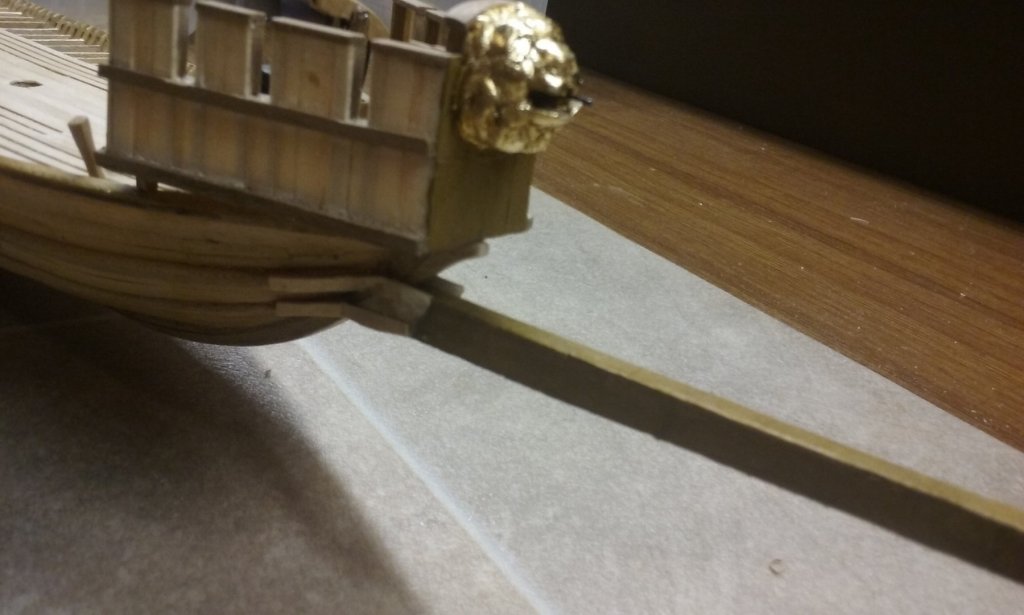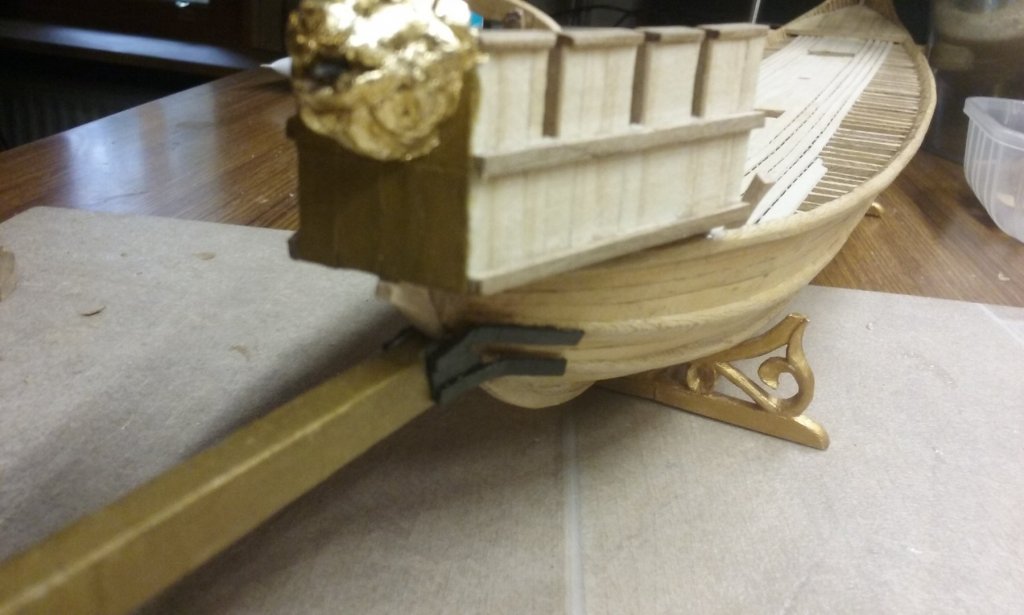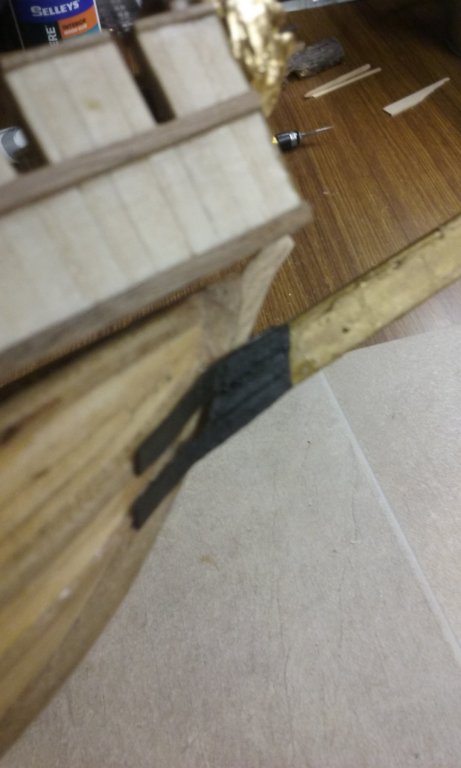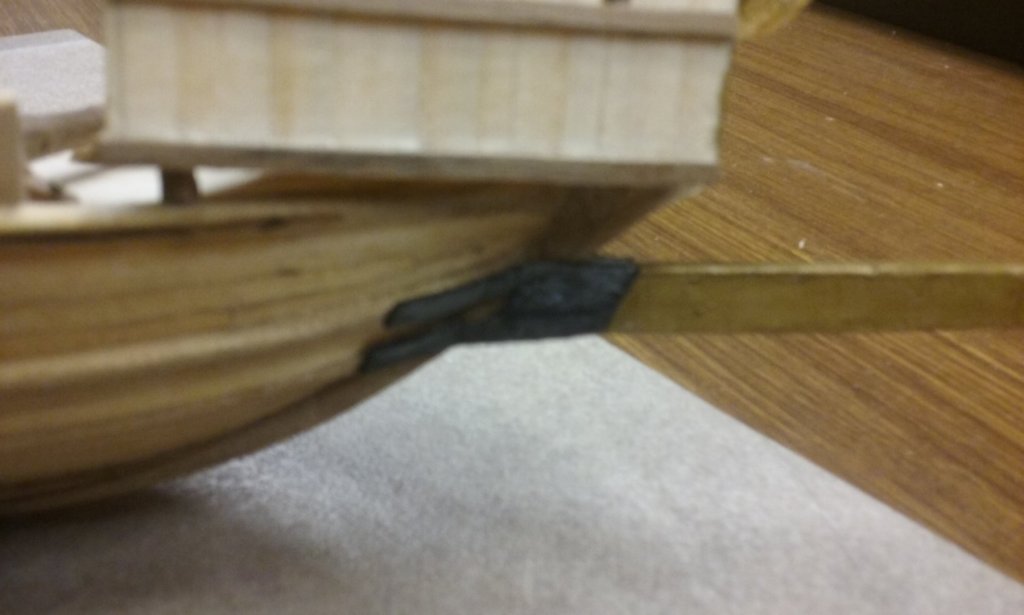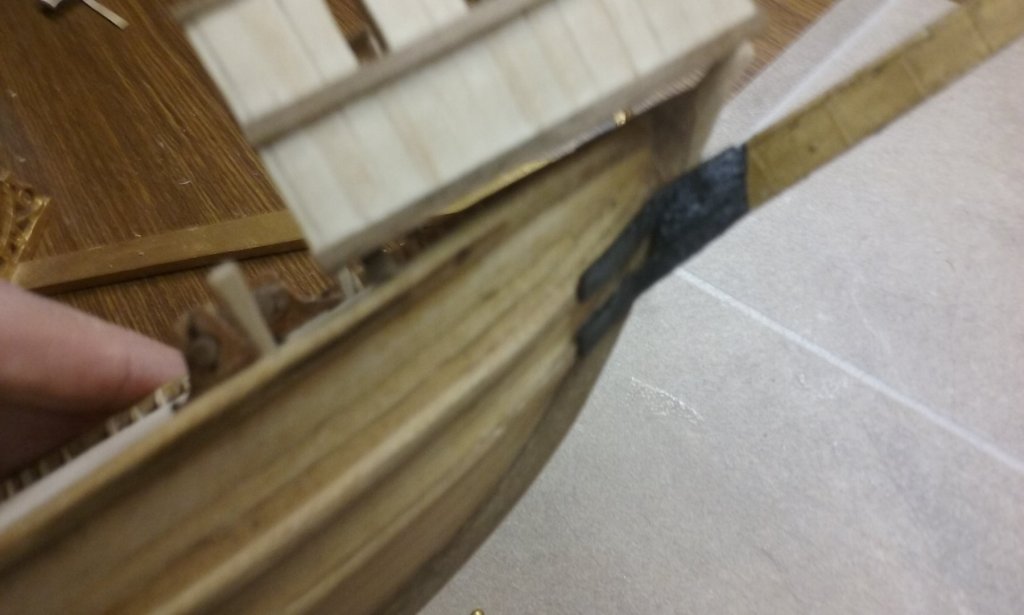-
Posts
7,973 -
Joined
-
Last visited
Content Type
Profiles
Forums
Gallery
Events
Everything posted by Louie da fly
-
So as far as I can see, the wheels of the chain pump are at right angles to the keel? I can see that having them that way makes it easier for the water to reach the lands and then run to the scuppers. But are there any cases of chain pump wheels parallel to the keel? Or is it a matter of choice from ship to ship? I'm getting the the point where I'm about to make my chain pump housings. I'd like to have my wheels parallel to the keel, but I don't want to get it wrong. Steven
- 12 replies
-
- chain pumps
- dromons
-
(and 2 more)
Tagged with:
-
Thanks for all the likes, people. And Patrick and Carl for the comments. A little more. I went ahead with the perimeter battens for the hatch cover.I think it looks better, particularly with the contrasting wood colour. And someone climbing up the ladder from below decks (just for the moment- he has other duties when the ship is complete). The mediaeval Byzantine sources mention supporting stands for the yards and for the masts when they're lowered - two different structures with two different names. I couldn't figure out why until recently. Then the light bulb lit up - the yards are considerably longer than the masts - you can't use the same stands for the two different things. But I suppose the mast stands could also help support the lowered yards. Started on the wedges for the masts - I've never done this before, and I'm just feeling my way. Not a bad beginning, though; just needs a bit of tweaking. Steven
-
Ladder belowdecks. I had to do this three times. The first was terrible - crooked, too narrow (it scaled about 30cm = 12" wide) and with the treads at all kinds of different angles, and looked like they were too close together. The next was better; wide enough, treads all in alignment, and not crooked. But the stringers were too thin - the slots for the treads made them likely to break off. And on checking against a full size ladder I realised the treads were too far apart (in scale) to be used by any sort of normal sized human. So, onto version 3. The ladder is the same width, length and angle, and all the treads nicely in alignment. Stringers thicker to allow for the slots for the treads, and enough treads so you wouldn't have to strain yourself reaching from one to another. Turns out the first ladder had the right number after all . . . I think my precision has improved. But I need to get into the habit of taking enough care the first time. If at first you don't succeed, use a bigger hammer? Steven
-
I've been off doing other things for a while. It's nice to get back to what my family call "boating" (to go along with my workshop which they call "the boat room"). I've made a cover for the hatch. I've kept the planking format I've been using for the deck, to allow air to get below decks so the oarsmen don't all collapse. It's not the same as the "criss-cross" halving joint method you see on the hatches of later ships - I have no evidence at all how such a hatch cover was constructed for a dromon (it's only an assumption it had one at all, otherwise how do you get cargo below). So it's planks with gaps between them, and cross-beams at intervals to support the planks so they don't deform or collapse when someone stands on them. Here's the frame for the hatch itself: And here is the frame for the hatch cover. (The other two bits of wood are for the ladder down to the lower deck.) Took quite a lot of mucking around till it fitted smoothly. Planking at each end. Intermediate planks Cross-beams Cover in place And lying on the deck with the hatch open. I'm just wondering whether I should also do a "border" around the top of the cover; does it look better with these battens around the perimeter? (they're just loose at the moment) Or should I leave it without them as in the pictures above? I'm just a bit concerned that without the perimeter battens it looks a bit too much like the duckboards you get in a sauna. Any suggestions welcome. Steven
-

Clotilda, last US slave ship, found
Louie da fly replied to bruce d's topic in Nautical/Naval History
Interesting. If that's a picture of her in the background, she looks really built for speed. Steven -
That's very worthwhile information, Binho. I couldn't remember when this ship was dated to - I remembered there was a Roman vessel in there somewhere, but on looking this one up it turns out to be from the 13th or 14th century, so it's very good not only for Woodrat's model, but for those others of us also interested in ships of this period. An interesting thing in my view is the poop superstructure - the framework doesn't seem to have been squared off at all but appears to be just bits of tree trunk with the bark taken off. I don't think this is just an apparency caused by the accumulation of sediment, because the frames certainly look squared off. Steven
- 263 replies
-
- nave tonda
- round ship
-
(and 2 more)
Tagged with:
-
Deciding on the deck features is a bit of a poser, which I'm currently puzzling over with my own build. No surviving deck = nothing to base the reconstruction on = mostly guesswork. I agree with Mark, though. A partially planked deck would simultaneously show the structure and the finished look of the deck. However, things which are on the centre line of the deck, such as the windlass, might require a different approach. It's looking very good, Dick. Adding the planking has yet again changed the look considerably. Are you going to completely plank one side? Steven
- 263 replies
-
- nave tonda
- round ship
-
(and 2 more)
Tagged with:
-
Yes indeed. I've been there twice. So I've seen the Walls and the Golden Gate and been inside Agia Sophia and I know where the Yenikapi finds were discovered. I hope to go back one day. Lots still to discover that I missed out on before. Steven
-
Thanks Mark (Taylor). Interesting point, Mark (Pearse). Unfortunately we'll never know. I think I'll stick with what I believe to be the simplest explanation - the miniaturist made a mistake. But I could be wrong . . . And yes, those faces are very expressive, aren't they? The Madrid Synopsis Historion was illustrated by as many as 7 miniaturists (the academics don't agree on this one) and in my view the one who did both of these pictures was the best of them. Steven
-
Thanks Patrick and Fabio. Good luck with finding a place to stow the bars. That's not the way I see it. The miniaturist's job was to illustrate clearly what was going on as simply as possible. Introducing a banner with a cross above those known to be Muslims would just cause confusion. I just think he got it wrong. Not in the case of Byzantium. There were quite a decent number of secular histories written about this time, which though they gave lip service to the usual religious formulas, were pretty much simply records of what had happened. They suffer from the usual biases you get in "histories", but these tended to be political rather than religious - depends which faction you belonged to, or which political group. Steven
-
The picture in my earlier post represents Thomas the Slav, who was making a bid to overthrow the Emperor and become Emperor himself, negotiating with saracens to get them to join him. Thomas would have had a flag to back up his claim to be Emperor. The banner with the cross on it is almost identical to that flying on the Emperor's own ship, and I think the illustrator who gave the saracens a flag with a cross on it must have been having a senior moment, and put it above the wrong set of horsemen. And then thought "Damn! Got it wrong! If I just pretend it didn't happen, probably nobody will ever notice . . . " Steven
-
Thanks for the likes, everyone. Carl, it did cross my mind to make the ship weatherbeaten, like some of the amazing ships we see on this forum. But I'll have to keep that for future models. This one's supposed to be pretty. No, Pat. There's really nothing in any contemporary account or illustration. For heaven's sake, it's only an assumption that the word used in the sources for this thing really means what we think it does. The original Greek word translates as "fastener", or even "brooch". The triangular gussets sound like a good idea in hindsight, but I don't think I'll do anything about it. I think it would all be pretty strong in the real world - please note that each of the straps runs along a wale. The idea I have is that the straps are fastened at relatively short intervals to the wales (probably with nails or long rivets, but I haven't shown any fastenings because I don't think they'd be visible at this scale), and the forces of ramming would be transferred via the straps to the wales, which are among the strongest timbers in the ship. Steven
-
Beautiful work, Patrick. A pleasure to watch. Steven
- 756 replies
-
- galleon
- golden hind
-
(and 2 more)
Tagged with:
-
Beautiful work, John. This build is a pleasure to follow. I'll have to find an excuse to come up and see the modelmaker's bench in operation in Sydney . . . Steven
-
I've attached the "iron" (really cardboard) brackets for the spur and painted them to look like iron. First, a coat of black Then a thin layer of silver to make it look a little more metallic. I thought of doing some rust, but this is the Emperor's ship, and anyway the model represents it in brand spanking new condition. Here are the bars for the windlass all done. Still got to find somewhere to stow them when not in use. I've also found a banner that looks pretty cool. Again, from the Skylitzes Chronicle (mid-late 12th century). This one has a cross on it, known as a cross pommée or pommelée (like a pommel, the knob at the end of a sword hilt, that acts as a counterweight to the blade). This must be where the flag came from for the modern reconstruction painting that Nikiphoros posted earlier, but I notice they changed the pink to red - not manly enough, perhaps?). Still not sure if I'm going to use this one or the one on the ship in an earlier post, where everybody's hair is blowing in the wind . . (thinks: that would be a good name for a song . . .😉) [Edit] Can any native Greek speakers make out what the word is next to the group carrying the banner? It appears to be narakagoi, or perhaps oi rakynoi? (allowing for the 12th century handwriting), but I'm really not sure, particularly about the last few letters. I don't want to use a banner that turns out to be used by someone not Byzantine. [2nd edit] The word turns out to be "sarakenoi" = saracens, so obviously I can't use it. But so, why are muslims using a banner with a cross? All getting converted? Perhaps the artist just wasn't really thinking . . . Steven
-
Beautiful work, Dick. I stand amazed at the thoroughness of your research and your ability to translate it into real-world modelling. Steven
- 263 replies
-
- nave tonda
- round ship
-
(and 2 more)
Tagged with:
-
How did I miss this until now? Very impressive, Peter. And very fast work without sacrificing quality in the slightest. At the beginning of the build you commented on whether or not you had put the log in the right place. I assume that's because you're not building the model exactly the same as the kit, with no rudders etc. No problemo - that's what we call kit-bashing, and is usually better than how it comes in the kit because the builder has invested more care and attention - and research - into it than the kit manufacturers were prepared to. I don't usually follow modern builds - I'm more a mediaeval/renaissance guy - but this build is really beautiful. Steven
- 35 replies
-
- fairmount alpine
- billing boats
-
(and 1 more)
Tagged with:
-
I'd agree with you - those floorboards look too far apart. I think moving them closer together would be an improvement. I can't see part 18 anywhere, so can't help with the balustrade. Maybe some pictures of the problem? I've got Roth's book and you're right, it does have its limitations. It was written over 30 years ago, and things have changed a lot in that time. The build is looking very good. I'm looking forward to seeing more . . .
-
A very nice collection, mate. keep up the good work. Steven
- 73 replies
-
- mediterranean
- galley
-
(and 1 more)
Tagged with:
-
Thanks everybody for the likes. It does help getting them, particularly when things get difficult (such as when I discovered I couldn't have the full complement of upper oarsmen😠). Druxey, yes I'd already thought of that, and I sheathed the spur in fake copper alloy sheeting. (Archaeologists used to call this stuff bronze, but they discovered its chemical composition was so variable that it could just as easily be called brass, so they changed the name). Mine is made of aluminium foil from the little containers the cat food came in, then painted with Humbrol "bronze" paint. Not sure if it's because it was an old tin (I bought it from a toy shop) or the fault of the paint itself, but it was very gluey and unsatisfying. However, it did the job. The front surface of the forecastle is also sheathed. John Haldon's 2006 experiment with it made it very obvious that heat shielding was absolutely necessary, and you could see from the video that a spur would have got covered with the flaming stuff. Steven
About us
Modelshipworld - Advancing Ship Modeling through Research
SSL Secured
Your security is important for us so this Website is SSL-Secured
NRG Mailing Address
Nautical Research Guild
237 South Lincoln Street
Westmont IL, 60559-1917
Model Ship World ® and the MSW logo are Registered Trademarks, and belong to the Nautical Research Guild (United States Patent and Trademark Office: No. 6,929,264 & No. 6,929,274, registered Dec. 20, 2022)
Helpful Links
About the NRG
If you enjoy building ship models that are historically accurate as well as beautiful, then The Nautical Research Guild (NRG) is just right for you.
The Guild is a non-profit educational organization whose mission is to “Advance Ship Modeling Through Research”. We provide support to our members in their efforts to raise the quality of their model ships.
The Nautical Research Guild has published our world-renowned quarterly magazine, The Nautical Research Journal, since 1955. The pages of the Journal are full of articles by accomplished ship modelers who show you how they create those exquisite details on their models, and by maritime historians who show you the correct details to build. The Journal is available in both print and digital editions. Go to the NRG web site (www.thenrg.org) to download a complimentary digital copy of the Journal. The NRG also publishes plan sets, books and compilations of back issues of the Journal and the former Ships in Scale and Model Ship Builder magazines.


